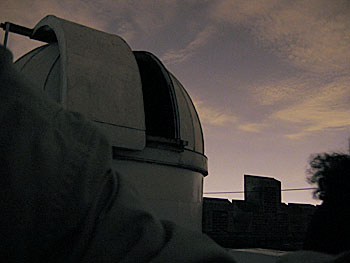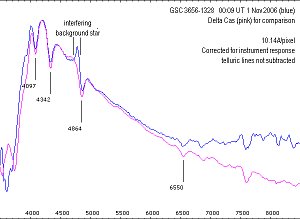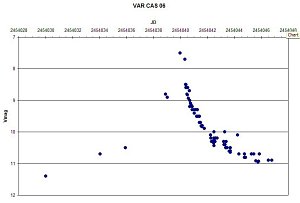
Akihiko Tago of Japan discovered a new bright star in the constellation Cassiopeia on October 31st. Checking back on his images he found the star brightening over the course of a week. New variable stars are discovered rather frequently; novae occur in the Milky Way every year and a few reach naked eye brillance; most are distant and only brighten to 8 or 9th magnitude (which requires binoculars or a telescope to see). In fact Tago is a nova hunter; he photographs the Milky Way constantly in search of new stars. But this new object wasn't a nova.
The new variable in Cassiopeia was identified as being in the same position as a magnitude 11 star--an unremarkable A-type star at 1,000 parsecs, a lot like Vega, which is hotter than the Sun with a surface temperature of about 10,000K. The problem is normal A-type stars are not known for their variability--there are few mechanisms to allow stars of that type to change in brightness, especially by 4 magnitudes. To do so, a star would have to expand 6-7 times in diameter without changing temperature or increase its surface temperature by 2.5x (which would completely change its stellar classification).
A spectra of the star would help identify what had changed about the star to make it brighten. Robin Leadbeater took one, but at first thought he was getting mixed light from a background star, since it didn't have a prominent hydrogen-alpha line like new nova do. Later spectra though proved he was getting the star itself and the background star wasn't causing a problem. There was simply nothing odd about the star that anyone could see.

M. Mikolajewski, T. Tomov, A. Niedzielski, K. Czart, and C. Galan from Nicolaus Copernicus University then suggested it might actually be a microlensing event--an object passing between us and the star that bent light so as to act like a giant lens for us--and brightening the star by a factor of 40x. This was amazing as microlensing events are very, very rare. A project called MACHO looks at the Large Magellanic Cloud and the center of our galaxy for microlensing events, but out of 18 million stars, they've detected 4 in between the LMC and us, and 45 in the direction of the galactic bulge. To have one affect a star and brighten it to nearly naked eye visibility is astonishing (although other groups have detected more events. See OGLE for example--they get about 500 a year looking at 120 million stars).
Extraordinary claims need extraordinary evidence, though, so everyone is closely watching the star as it fades back to normal. It needs to do so in the exact timeframe that it took to brighten.

Another interesting possibility is if the lens itself is a fainter star with a solar system, the planets can also microlens the light, albeit for only short periods of a few hours. These spikes on the main event are a hot topic for microlensing studies and exoplanet hunters.
For a "standard" microlensing event, take a look at this one: 4 magnitudes over a few days time.
Interested in the theory behind microlensing? Take a look at this FSU course.
To see the star at or near maximum, see: http://www.irishastronomy.org/
or here, although the star is not marked and is not obvious (magnitude 7.5 stars are a dime a dozen in the Milky Way).
Astronomers will be watching this star closely to see how the light dims in the next few weeks--to make sure it really was a microlensing event!
2 comments:
Michael Richmond just posted an analysis of data collected from the TASS survey: http://stupendous.rit.edu/tass/technotes/tn0104.html
A light curve with pre-discovery estimates is here: http://www.theastronomer.org/vars/2006/tago_cas_2006_v1.gif
Post a Comment